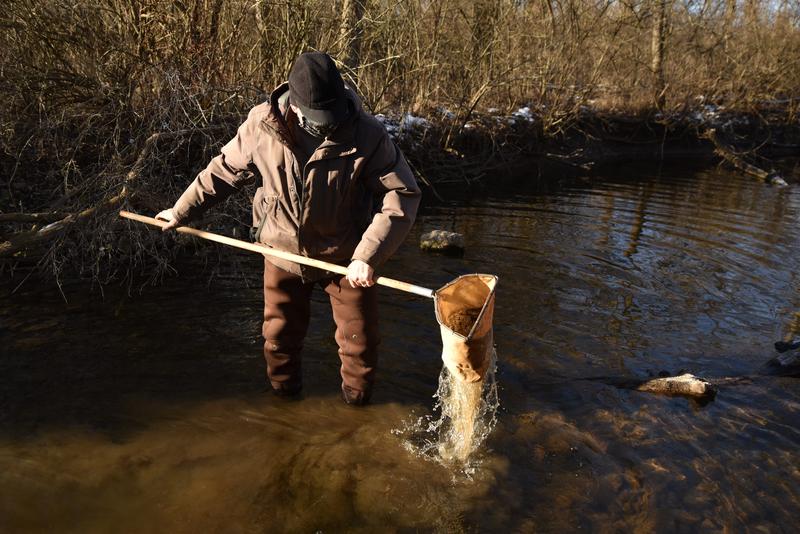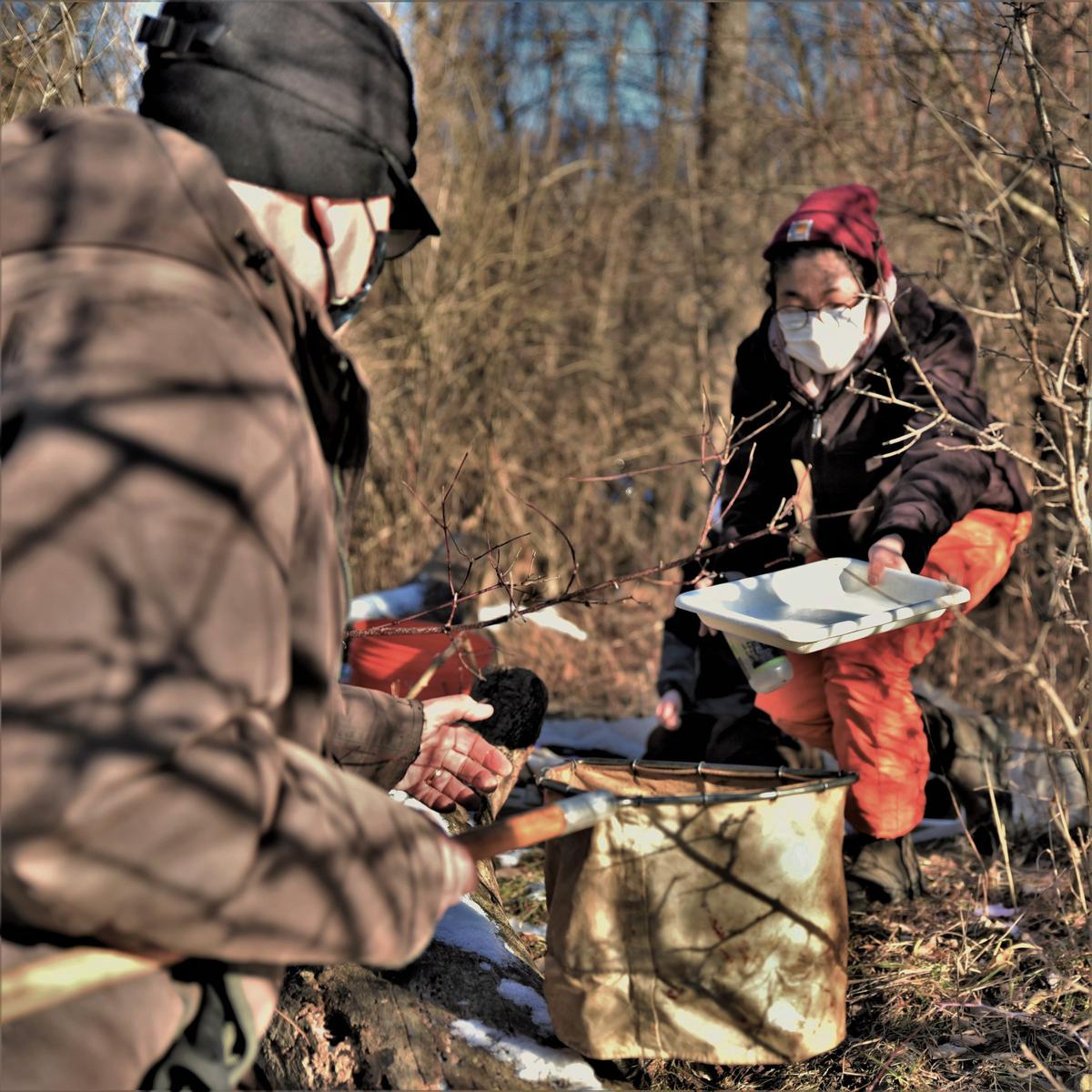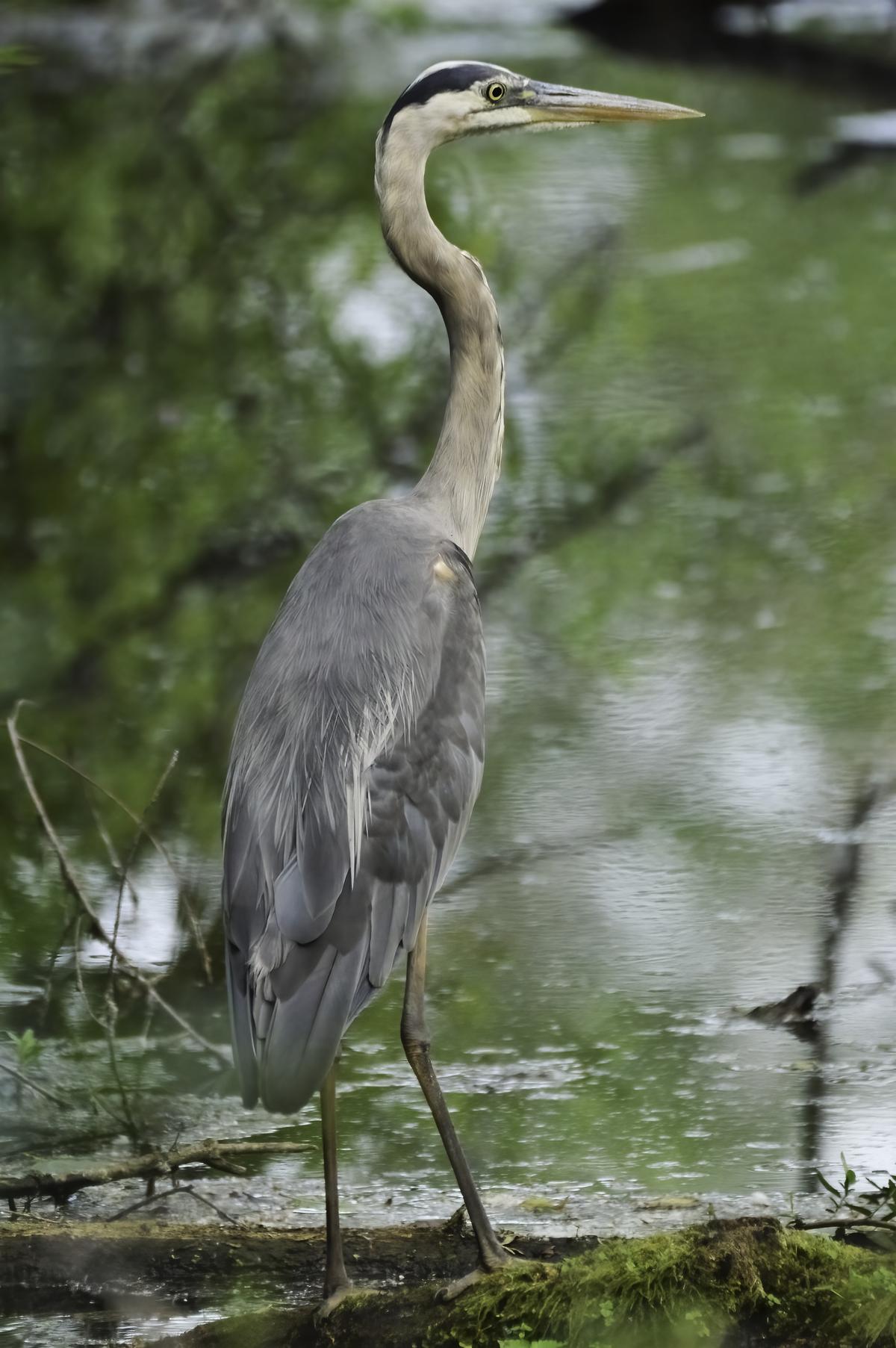
By Lester Graham, Michigan Radio
The Great Lakes News Collaborative includes Bridge Michigan; Circle of Blue; Great Lakes Now at Detroit Public Television; and Michigan Radio, Michigan’s NPR News Leader; who work together to bring audiences news and information about the impact of climate change, pollution, and aging infrastructure on the Great Lakes and drinking water. This independent journalism is supported by the Charles Stewart Mott Foundation. Find all the work HERE.
It’s freezing outside and Larry Scheer is in neoprene chest waders kicking up sediment in Boyden Creek near Ann Arbor. He’s using a fine mesh net to capture the detritus he’s stirred up. When he has enough in his net, he makes his way to the shore where Jenni Yim is waiting with a tray.

Larry Scheer and Jennifer Yim are volunteers with the Huron River Watershed Council. They’re among many who take samples to determine the health of streams and rivers. (Photo Credit: Lester Graham/Michigan Radio)
She and her 9-year-old son sort through the organic matter with tweezers, looking for a certain kind of insect.
“Take a look at this tray, because I think I see some stoneflies,” Yim says to her son before adding, “His eyesight is a lot better than mine.”
Citizen scientists like these all across the Great Lakes region volunteer to do this kind of work to help determine the health of streams and rivers.
On this day crews were working over a wide area for the Huron River Watershed Council.
“Fundamentally, stoneflies, other insects are really good indicators for any number of metrics on environmental health, so they’re good early warning systems when something is wrong with a stream or a creek or a small lake,” said the Watershed Planner for the organization, Daniel Brown.
When they can’t find stoneflies, they try to determine why. It could be some kind of pollution, some kind of organic pest, or one of the many other challenges streams face. While Brown is the watershed’s project manager, he’s also a climatologist.

Ducks in the Red Cedar River in the summertime. (Photo Credit: Lester Graham/Michigan Radio)
“In many cases, climate change amplifies existing stressors,” he said.
One of the major issues amplified by climate change has been an increase in the intensity and frequency of heavy rainstorms.
“Intense storm events lead to intensive flooding, which can lead to erosion of stream channels, habitat can be removed depending on the magnitude of a storm, fish can be washed away. There’s a whole bunch of effects that these large floods can have on the ecology of river systems,” said Dana Infante, a professor and assistant director for natural resources at Michigan State University AgBioResearch.
She said the timing of a storm can change when fish spawn or migrate. It can change the moment when insects emerge, which are food for fish, frogs and birds. Timing is everything in nature. Birds migrating to the north depend on certain insects to be there as they travel through the upper Midwest.
Later, in the summer, if an intense storm happens, there are other problems.
“You can imagine in the summer you’ve got an asphalt parking lot, black asphalt parking lot that is a couple of hundred degrees and suddenly you get a flash rainstorm,” said Jan-Michael Hessenauer with the Michigan Department of Natural Resources.
“That water hits that parking lot. It warms up very quickly and then, bam, it’s in the stream real quick. So that can cause a real sudden temperature shift,” he explained.

A great blue heron on the banks of the River Raisin. (Photo Credit: Lester Graham/Michigan Radio)
Streams have already been warming because of the gradual increase in air temperatures caused by climate change.
However, that’s not the only thing that happens during those sudden, drenching storms.
“When you have a big rainstorm, it flushes everything that’s in the parking lot into the drain and that eventually ends up in a river or a creek somewhere, when you have a heavy storm that hits an agricultural field, you know, the fertilizer, the nutrients that were applied to that that field are going to end up in a river at some point,” said Daniel Brown with the Huron River Watershed Council.
When it’s not storming, creeks and rivers are still hit by climate change. In farmland areas and developed areas many trees that once towered over streams have been cut down.
“That shade is really important to prevent that kind of daily fluctuation, so you lose that, you suddenly have sun baking down on the water, that can increase the temperature quite a bit and that stresses aquatic life and may cause some changes in the types and numbers of species that inhabit those streams,” Hessenauer said.

A softshell turtle in the Cass River near Saginaw. (Photo Credit: Lester Graham/Michigan Radio)
Michigan State University’s Dana Infante said forested areas protect streams in another way as well. They slow the rush of water and everything that it carries.
“If you had a river in a forested landscape, it’s likely that more water would seep into the groundwater table and be delivered slowly and more regularly to the river network. This notion that we’re talking about is the idea of resilience and ways to make rivers resilient to changes in climate,” she said.
That resiliency can also happen on land in the form of what’s called green infrastructure. Storm drains rush water into streams. But rain gardens, bioswales, retention ponds and fewer impervious surfaces help slow the water and allow some of it to soak into the ground. That reduces damage to streams.
There’s another factor that’s warming rivers and streams across the upper Midwest. We’ve dammed up many rivers and turned them into a series of connected lakes instead of free-flowing streams.
“Whereas the water might lose heat and move along fast enough before it can warm up, now it’s warming up as a part of a lake. That gives you opportunities for other bacteria to build up in the lake. And it creates other stressors on wildlife, insects, birds, fish, of course,” Daniel Brown said.
From Ann Arbor to the point the Huron River enters the Detroit River, there are eight dams. Some of them are hydro-electric dams, providing electricity without burning fossil fuels such as coal and natural gas.
Brown is involved in a planned dam removal on the Huron River. The Peninsular Paper Company dam, owned by the city of Ypsilanti no longer generates power as it once did. The city and the Huron River Watershed Council agree the dam is obsolete, it should be removed, and that section of the river restored.
API key not valid. Please pass a valid API key.Dana Infante said dam removals can help cool water temperatures in some cases, but there can be complications.
“Dam removals also have to be balanced with the reduction in the spread of non-native fish species in the basin,” she said.
For example, dams help block the parasitic sea lamprey from swimming upstream to spawn. Before control measures were put in place, lamprey devastated fishing in the Great Lakes.
Rivers are in much better shape than when rivers such as the Rouge and Cuyahoga caught fire in the 1960s. But with growing challenges caused by climate change, Infante said people as well as colleges, governments and nonprofits will have to work together to find solutions, but it won’t be easy and it won’t be cheap.

The Grand River near downtown Lansing, Michigan. (Photo Credit: Lester Graham/Michigan Radio)
“Are we willing to put the effort into planting trees or paying tax dollars to conserve these ecosystems,” she asked.
The other choice is to accept that certain kinds of fish, insects, birds and amphibians are not going to be able to survive with warmer rivers.
“An important part of fighting climate change is building resiliency into these systems, so if you have stream banks that are better managed, that have proper vegetative cover, that can provide shelter and shielding of the stream itself from sunlight, that can have essentially the ecosystem functioning more properly. It’s going to be more resilient to change,” said Jan-Michael Hessenauer with the Michigan DNR.
There’s an added bonus for people in making that happen. Building resiliency can also help reduce the severity of floods caused by intense storms that damage homes, destroy property and endanger lives.
Catch more river news on Great Lakes Now:
University gives St. Marys River clean, green boost
GLWA, DWSD and Oakland County working together to reduce overflows into Rouge River
Program to study Clinton River to improve water quality
API key not valid. Please pass a valid API key.Featured image: Larry Scheer collecting samples from Boyden Creek near Ann Arbor. (Photo Credit: Lester Graham/Michigan Radio)





